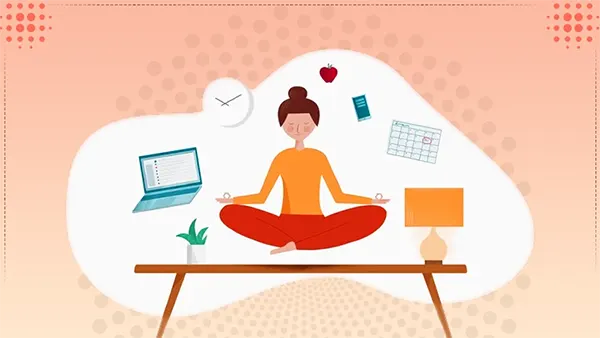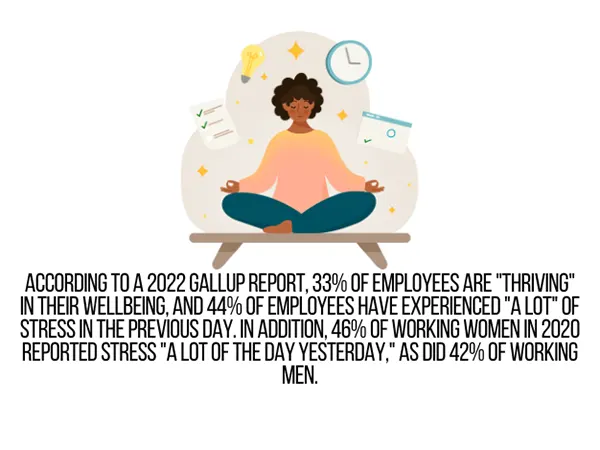
The modern workplace can be pretty chaotic, especially if you are stuck in front of a screen, completing document after document of never-ending work.
Staying focused and productive in such a situation can be hard.
The constant buzz of activity all around you, the hum of office printers going about and the sedentary nature of desk jobs can lead you to get mentally exhausted and make mistakes.
But is there a way to solve these issues?
The good news is that there are ways that can help you cope with the stress and humdrum of daily workplace stress easily.
And the best part is that these steps are not that hard to put into practice.
In this blog post, we will take a look at some wellness techniques that help you deal with workplace stress.
9 Workplace Wellness Rules
You know, your workplace is not the most ideal place to relax.
There will always be things that will stop you from relaxing your mind and add to the daily stress of increased workload.
It can become a pretty depressing place to go.
DID YOU KNOW?
70% of employees enrolled in wellness programs have reported higher job satisfaction than those not enrolled in the companies’ program.
But you do not need to worry, here are some things that can help you create a space where you can relax and focus more on your work without any distractions.
Ergonomic Setup
In an office space, you don’t always have access to the best workstations.
You need to get the chair and desk just right to make it an ideal place where you can stay relaxed and focused.
Set the chair in such a way that your feet rest flat on the floor, with your knees at a right angle.
You can also use a cushion to support your lower back.
Aside from this, the top of the computer screen should be at eye level (this way, you won’t be straining your neck looking up or down).
And hey, lighting matters too.
A good workspace should be well-lit, but avoid harsh lights directly above or behind you because they can cause glare on your screen.
Of course, natural light is best but if that’s not an option, a good quality desk lamp can help.
This environment will keep your eyes from tiring out and help maintain concentration.
Regular Breaks
Hey, everyone needs breaks every once in a while.
Think about taking a five-minute break to stretch, walk, or just chill.
Do anything that will keep your brain fresh.
Use this time to not think about work. Maybe do some quick exercises, water your plants (if any), or just stare out the window.
The best strategy here is to mix it up.
Don’t just go to the break room and back. Take a different route, go outside, or do a quick meditation.
You will feel more productive when you return to your tasks.
Task Prioritization
List your day out and plan around it.
Every morning, write down what needs to be done.
Put the big, must-do tasks at the top. When you tick these off, it’ll give you a real boost.
This may make the rest of the day seem easier.
Use tools like apps or planners to keep track of your priorities, these tools can remind you of deadlines and help you manage the task at hand much better.
Find a tool that works and use it to keep your workday on track.
Natural Supplements
Did you know that omega-3s and B vitamins can improve focus and cognitive function?
Start with a balanced diet, then explore different types of adaptogens if you need an extra boost.
If you don’t know how a supplement works, check with a healthcare provider.
Herbal helpers can be a good option, in this regard, too.
Teas like ginkgo biloba or green tea are just superb for a mental lift. Plus, they can be a nice ritual to break up the day.
Mindful Eating
Plan your meals (that’s not easy but still).
Bring food from home if you can and focus on meals that include
- veggies,
- fruits,
- proteins,
- and grains.
Eat mindfully, which basically means paying attention to what you eat and how it tastes.
This can prevent overeating and improve digestion.
It’s always a good idea to schedule your snacks.
For example, have healthy snacks like nuts, fruit, or yogurt at set times to prevent the mid-afternoon slump.
Listen to your body’s hunger signals and respond with nourishment (instead of the familiar caffeine hit).
Hydration
Keeping hydrated is the most important thing when you’re busy with work.
It’s pretty easy to forget to drink when you’re too busy with work.
This is why you need to keep a water bottle on your desk and take a sip every so often.
And if plain old water feels too bland, you can even add lemon, cucumber, or fruit juice.
The goal here is to make drinking water a regular part of your day and chances are you’ll really achieve it if you make it more enjoyable.
Digital Detox
Sticking to that screen the whole day can be bad for your health too.
Prepare a digital detox by managing the amount of time you are looking at the screen.
One trick everyone (or almost everyone) can use is to set specific times to check emails.
Avoid social media during work hours (they are a poor distraction).
It’s better to be present with your tasks than try juggling a dozen digital conversations at once.
Tech-free zones can work well (of course, if your workplace environment permits that).
Create spaces or times where no devices are allowed.
This can be during meals, the first hour when you arrive at work, or during the first hour after the work is over.
This helps your brain to unwind and detox from digital stimuli. You’ll enjoy better mental clarity the next day.
Meditation
Who can say that meditation does not help at all?
Closing your eyes and focusing on anything but work is a great way to give your mind a rest.
You can just start with deep breathing for a couple of minutes.
The idea here is to do it regularly.
Besides, there are many meditation apps and videos on the internet that can help you get started.
Regular practice can help you achieve great things, like
- improved concentration,
- reduced stress,
- and enhanced decision-making capabilities.
Social Interactions
Its not good to be alone all the time.
If you want to have a better time at your workplace, you need to connect with your coworkers.
And its very easy to do so too.
Just take some time to chat or have lunch with colleagues.
Your conversations don’t have to be work-related. Talk about hobbies, interests, or weekend plans.
All of it can strengthen relationships and improve teamwork.
If you feel good as a team member, the work process will feel more enjoyable and productive, too.

Final Thoughts
As you see, it doesn’t require much effort to boost focus and productivity.
But, of course, it doesn’t come naturally either. Each of the nine practical tips discussed above can enhance printer users’ workplace wellness.
You don’t need to implement them all — just start with those that seem to be a good fit for you.
Soon enough, you’ll surely feel the difference in your daily work life.